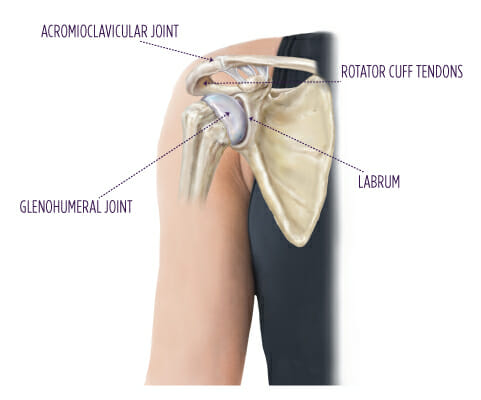
Anatomy of the shoulder
The shoulder is a unique and complex joint. The shoulder needs a high degree of flexibility, but it also needs to remain stable in multiple planes of motion. To accomplish this, the shoulder joint is supported by a combination of bones, ligaments, and muscles.
The shoulder is made up of the following parts:
- Acromioclavicular (AC) joint – where the collarbone (clavicle) meets the top of the shoulder (acromion).
- Glenohumeral joint – where the head of the upper arm bone. (humerus) and the shoulder socket (glenoid fossa of the scapula) meet.
- Labrum – a cartilage ring around the shoulder socket that makes the socket deeper and more stable for the humeral head to sit in. A joint capsule surrounds these structures.
- Rotator cuff tendons – tendons that attach the four rotator cuff muscles to the humerus to both maintain stability and move the shoulder in all directions.

What are the symptoms of a shoulder injury?
Symptoms of a shoulder injury include:
- Pain
- Instability
- Weakness
- Clicking or popping sensation
How are shoulder injuries diagnosed?
The diagnostic process starts by talking with you about your symptoms and conducting a detailed physical examination. Diagnostic imaging, including X-rays and MRI scans, can be useful for a diagnosis as well.
What are the treatment options for shoulder injuries?
Activity modification
Some symptoms can be relieved by avoiding activities that make your symptoms worse.
Anti-inflammatory medicines
Over-the-counter medications such as Aleve, Advil, Motrin, and aspirin can help reduce swelling and pain.
Icing
Place a bag of ice directly onto the shoulder for 20 minutes to reduce and prevent inflammation.
Injections
In the specialist’s office, medication is injected directly into the joint. Injections can provide lasting relief of pain and swelling.
Physical therapy
A therapist can work with you to improve strength and to teach proper shoulder mechanics.
Wellness
Start with a free wellness consultation to explore your goals and what tools are available to you.
Integrated physical therapy and wellness
Our team of physical therapists, performance specialists, and registered dietitians works collaboratively with you to design an integrated rehabilitation plan that will help you reach your full potential.
Surgery
If you fail to improve after nonsurgical care, your specialist may wish to intervene surgically. Your specialist can discuss the details of the surgery with you should it become necessary.
